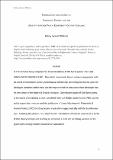Files in this item
Thomas Gray and the Goths: philology, poetry, and the uses of the Norse past in eighteenth-century England
Item metadata
| dc.contributor.author | Williams, Kelsey Jackson | |
| dc.date.accessioned | 2016-04-01T16:00:06Z | |
| dc.date.available | 2016-04-01T16:00:06Z | |
| dc.date.issued | 2014-09 | |
| dc.identifier | 241652153 | |
| dc.identifier | 9941f67d-3a4f-458c-a575-dbb43dbb5fcb | |
| dc.identifier | 84985930075 | |
| dc.identifier.citation | Williams , K J 2014 , ' Thomas Gray and the Goths: philology, poetry, and the uses of the Norse past in eighteenth-century England ' , Review of English Studies , vol. 65 , no. 271 , pp. 694-710 . https://doi.org/10.1093/res/hgu024 | en |
| dc.identifier.issn | 0034-6551 | |
| dc.identifier.uri | https://hdl.handle.net/10023/8544 | |
| dc.description.abstract | In 1761 Thomas Gray composed two loose translations of Old Norse poems: The Fatal Sisters and The Descent of Odin. This article reconstructs Gray’s complex engagement with the world of seventeenth-century Scandinavian scholarship: recovering the texts he used, the ideologies contained within them, and the ways in which he naturalized those ideologies into his own vision of the history of English literature. Gray became aware of Old Norse poetry in the course of composing a never-completed history of English poetry in the 1750s, but this article argues that it was not until the publication of James Macpherson’s Fragments of Ancient Poetry (1760) that Gray became inspired to engage poetically with the Scandinavian past. Imitating Macpherson, he created his own ‘translations’ of what he understood to be the British literary heritage and, in doing so, composed a vivid and surprising variation on the grand myths of early modern Scandinavian nationalism. | |
| dc.format.extent | 393755 | |
| dc.language.iso | eng | |
| dc.relation.ispartof | Review of English Studies | en |
| dc.subject | DA Great Britain | en |
| dc.subject | P Philology. Linguistics | en |
| dc.subject | PR English literature | en |
| dc.subject.lcc | DA | en |
| dc.subject.lcc | P1 | en |
| dc.subject.lcc | PR | en |
| dc.title | Thomas Gray and the Goths: philology, poetry, and the uses of the Norse past in eighteenth-century England | en |
| dc.type | Journal article | en |
| dc.contributor.institution | University of St Andrews. School of History | en |
| dc.identifier.doi | https://doi.org/10.1093/res/hgu024 | |
| dc.description.status | Peer reviewed | en |
This item appears in the following Collection(s)
Items in the St Andrews Research Repository are protected by copyright, with all rights reserved, unless otherwise indicated.

